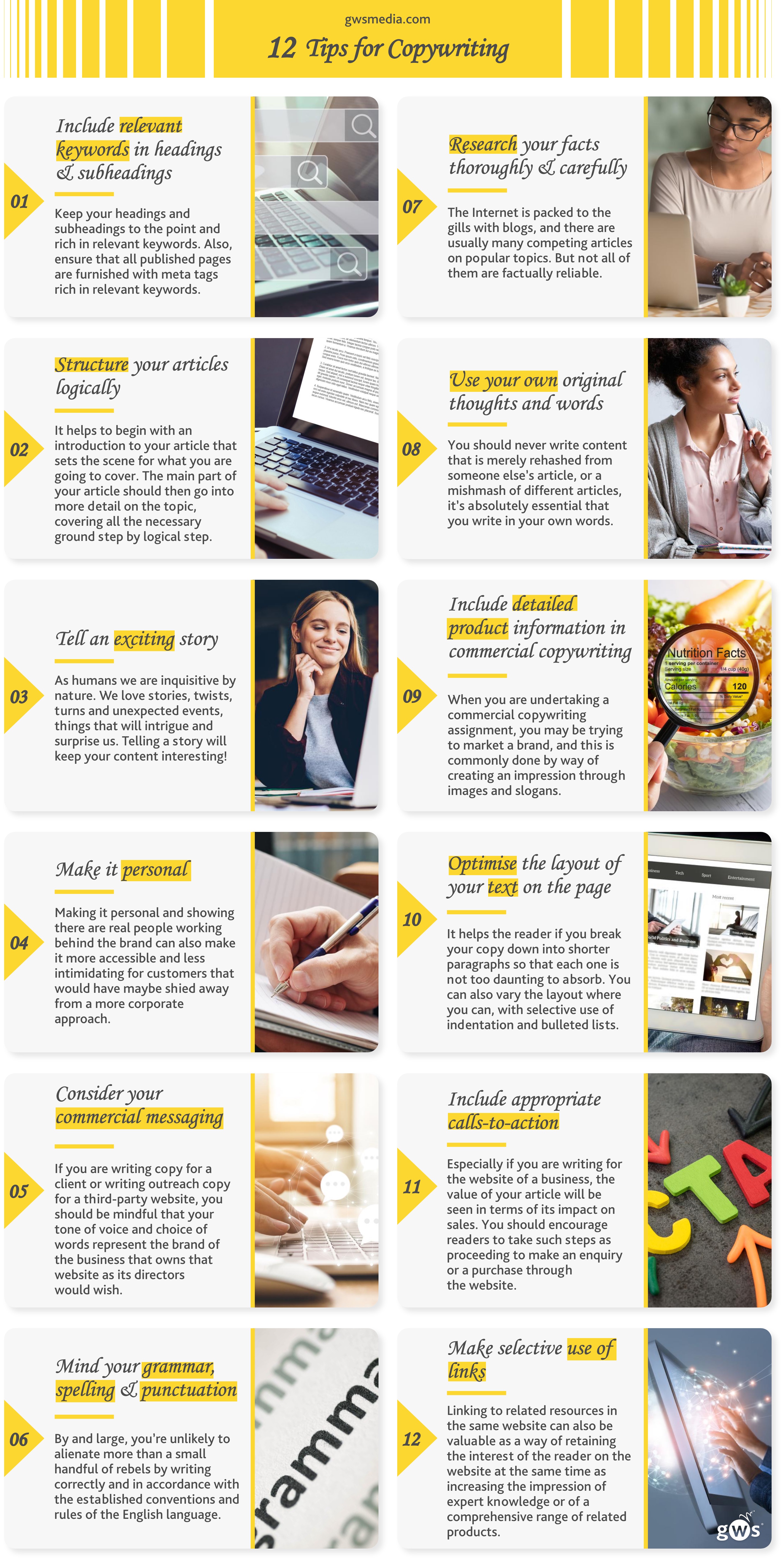1. Include relevant keywords in headings and subheadings

There are multiple benefits to including relevant keywords in both your main heading and subheadings.
In SEO terms, the headings and subheadings on a page contribute significantly to search engines’ impressions of the topical subject-matter of your page. If people are searching for topics you are covering in your article, and search engines such as Google can see that those topics are listed in your on-page headings and subheadings, they are much more likely to feature your article in the results listings for those enquiries. So you will get more genuinely interested and relevant traffic through to your articles than you would have done otherwise.
In user experience terms, headings and subheadings give advance notice to the reader of what is to be found in your article and in each part of it. A lot of readers are in a hurry, and they may lose patience reading through rambling text that is not directly of interest and want to scan through your article quickly for subheadings that speak out to them and then read the text beneath these.
So keep your headings and subheadings to the point and rich in relevant keywords. However tempting it may be to use witty allusions, cultural references and colloquialisms in your headings and subheadings, these are likely to be obscure to a great part of your audience and useless for search value, so resist the temptation and save them for body text if you must use them at all!
Once these have been finalised, you should also ensure that the published page is furnished with meta tags rich in relevant keywords so that it’s more likely to be found on search engines once they have indexed it.
2. Structure your articles logically

If you have ever had to write essays at school, you are likely to have been instructed to give them a clear structure, with a beginning, a middle and an end. However annoying you may feel it is to be hidebound by the regimented ideas imposed on you by schoolteachers, there was a reason for their methods, and it’s all about enhancing comprehension for the user.
Don’t forget that while you are likely already to know and understand everything you are writing, you have to assume that a great part of your audience will not. That is why they want to read your content in the first place – to learn something from you that they don’t know yet.
So think of yourself as a teacher, feeding information to a remote class of students. Your success depends on the clarity of your presentation as well as on retaining their interest and engagement. With this in mind, it’s important to structure your articles for their optimal information absorption and retention.
It helps to begin with an introduction to your article that sets the scene for what you are going to cover or address. In some cases, depending on the purpose of the article, this may take the form of identifying a problem or need for which a solution is required.
The main part of your article should then go into more detail on the topic, covering all the necessary ground step by logical step; or, if the article is more focused on presenting different choices for tackling a problem or different products in the marketplace, it will talk about each of them in turn, covering their advantages and disadvantages.
At the end of your article, it’s a good idea to recap and synthesise or summarise your findings by way of drawing a conclusion.
3. Tell an exciting story

As humans we are inquisitive by nature. We love stories, twists, turns and unexpected events, things that will intrigue and surprise us. Bear this in mind in your approach to copywriting.
Regardless of what you are writing about or the length of the copy that you need to write, always try to develop an underlying story within the text, a plot if you like, that people can follow. Gain the attention of the audience and maintain it throughout the piece. How can you make it exciting? How will you entice the audience to continue reading? Can you offer escapism or value-added content within the story that you will tell?
Just as you would if you were writing an actual story, use descriptive words, build suspense and include a big reveal at the end. Be mindful of getting too carried away, but you can always pare it back in subsequent edits if you do.
Telling a story will keep your content interesting, and will help it to stand out in the vast sea of content across the web.
4. Make it personal

The personality of a business, service offered or product can be a big contributing factor as to why a consumer would shop with them and feel a loyalty towards them. You’ve heard of the ‘personal touch’, and it does make a difference.
Consumers, more so than ever before, want to know about businesses’ missions, their values and what makes them different, so think about the ways in which you can get this across.
What you are writing about will obviously mean that what you can include may vary. For example, you may be writing a blog piece about start-ups that would benefit from an anecdote or quote from the business founder or perhaps a product description that may benefit from a customer testimonial. As and where relevant, bring out the personality of the business when you can. If not anecdotes and comment, think about the tone of the piece.
Making it personal and actually showing there are real people working behind the brand can also make it more accessible and less intimidating for customers that would have maybe shied away from a more corporate approach.
5. Consider your commercial messaging

The tone and lexis in which you write on any website that belongs to or represents a business is a part of the commercial messaging, and therefore also the branding, of that business.
If you are writing copy for a client or writing outreach copy for a third-party website, you should be mindful that your tone of voice and choice of words represent the brand of the business that owns that website as its directors would wish. If you don’t know the directors personally, then consider the existing tone of the website and try to keep your writing compatible with it. You certainly don’t want to be alienating any of their customers or target market with anything you write for them.
If you are writing for your own website or business, then do some extent you have carte blanche to decide upon the appropriate tone for your audience or target market, depending on whether it’s a hobby-related website or a business one. Even then, you should consider your messaging carefully.
Could anything you write be construed as offensive to certain sections of society, or is your humour likely to be taken the wrong way by some? If so, rein yourself in! While having a sense of humour is a popular attribute in most cultures, humour doesn’t always transpose well across international borders or even within the subcultures and regions of a particular country’s culture. And in business, sometimes a serious front is a safer passport to credibility. An off-colour joke could cost you the confidence of some of your customers. And once you’ve lost their confidence, you’ve lost their trust.
It is also worth bearing in mind that flattering the company’s own products or brand as a way of driving demand for them is unlikely to be successful. Instead, you need to sell their benefits to the potential customer. So avoid ego-indulging statements of the ilk of ‘We are the foremost provider...’ / ‘We are the biggest supplier’, and instead explain how and why dealing with you instead of with the competition will benefit the customer.
6. Mind your grammar, spelling and punctuation

The users of the world wide web are split between those who don’t give two figs about correct grammar and spelling and those for whom a single misplaced apostrophe or Americanised turn of phrase is at best a cause for a passing wince and at worst a major turn-off. While the former category of reader probably won’t trouble you whatever you do (and some might even find excessively formal language too much to stomach), the latter will be sensitive to any poor spelling, grammar or punctuation, and may be inclined to associate deficiencies in these areas with lesser intelligence on the part of you and your team, ultimately inclining them to expect a lower-quality service or product from you.
By and large, you’re unlikely to alienate more than a small handful of rebels by writing correctly and in accordance with the established conventions and rules of the English language, but you will lose the confidence of a great many by writing sloppily.
So pay attention to your grammar, spelling and punctuation, and if any of these is not your strongest point, find someone who is genuinely competent at English to edit your copy. There are professional copy-editors and proofreaders for hire, but not all are equally competent, and some may apply the rules of American English, which are generally significantly different from what the UK market demands and expects. The same goes for automated spell-checking and grammar-checking tools such as those built into popular word-processing programs like Microsoft Word.
In contrast, either a native British English speaker with a degree in either English literature or a foreign language, or even a foreign native with a degree in English language or literature obtained while studying in the UK, is unlikely to go far wrong, and could be a hidden asset to your finished product.
Looking for more tips? Have you read Part Two: Copywriting Tips 7-12 of this article? If, following that, you would like some further guidance on copywriting, try our Digital Copywriting Guide to Best Practice.

